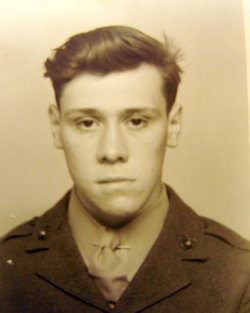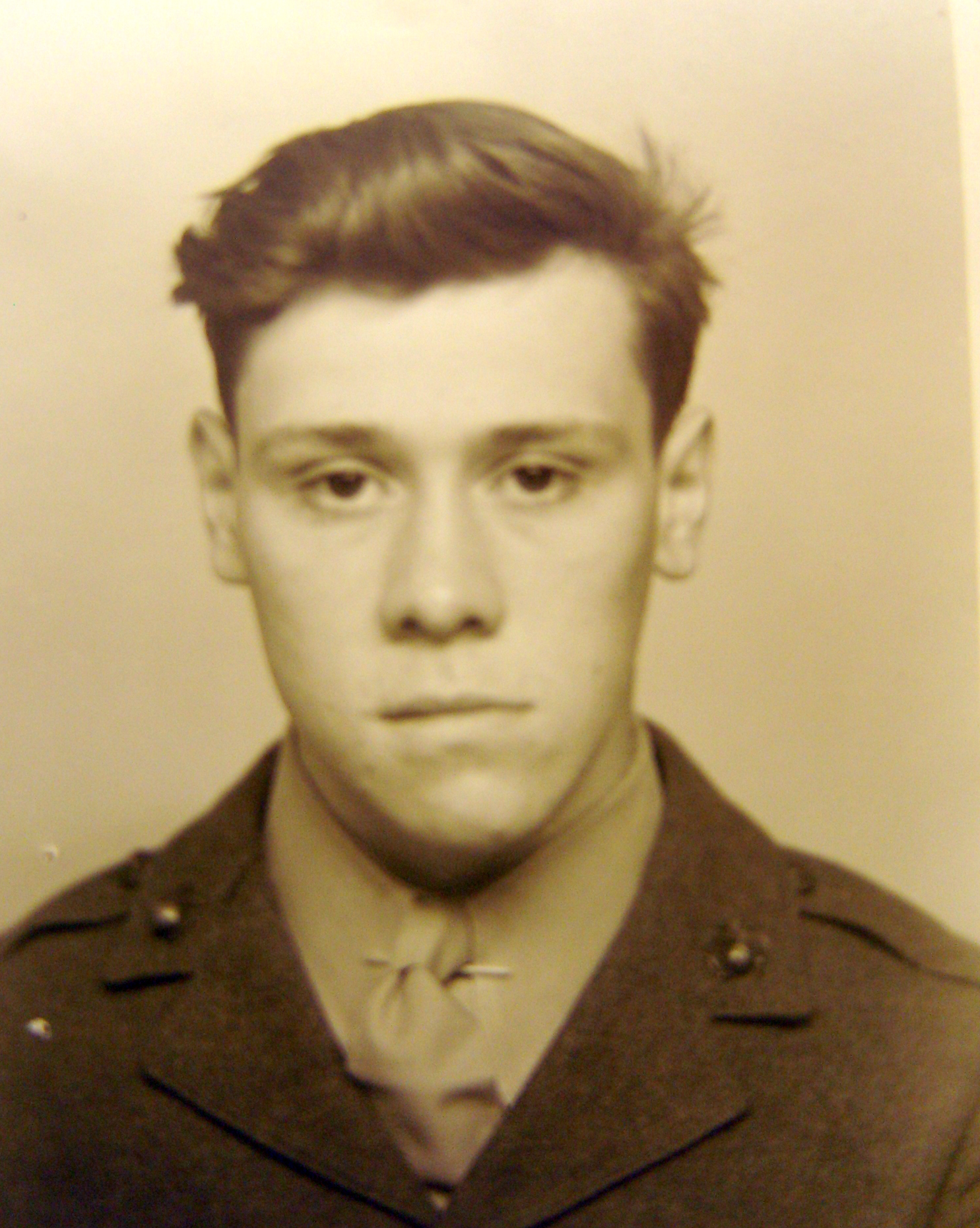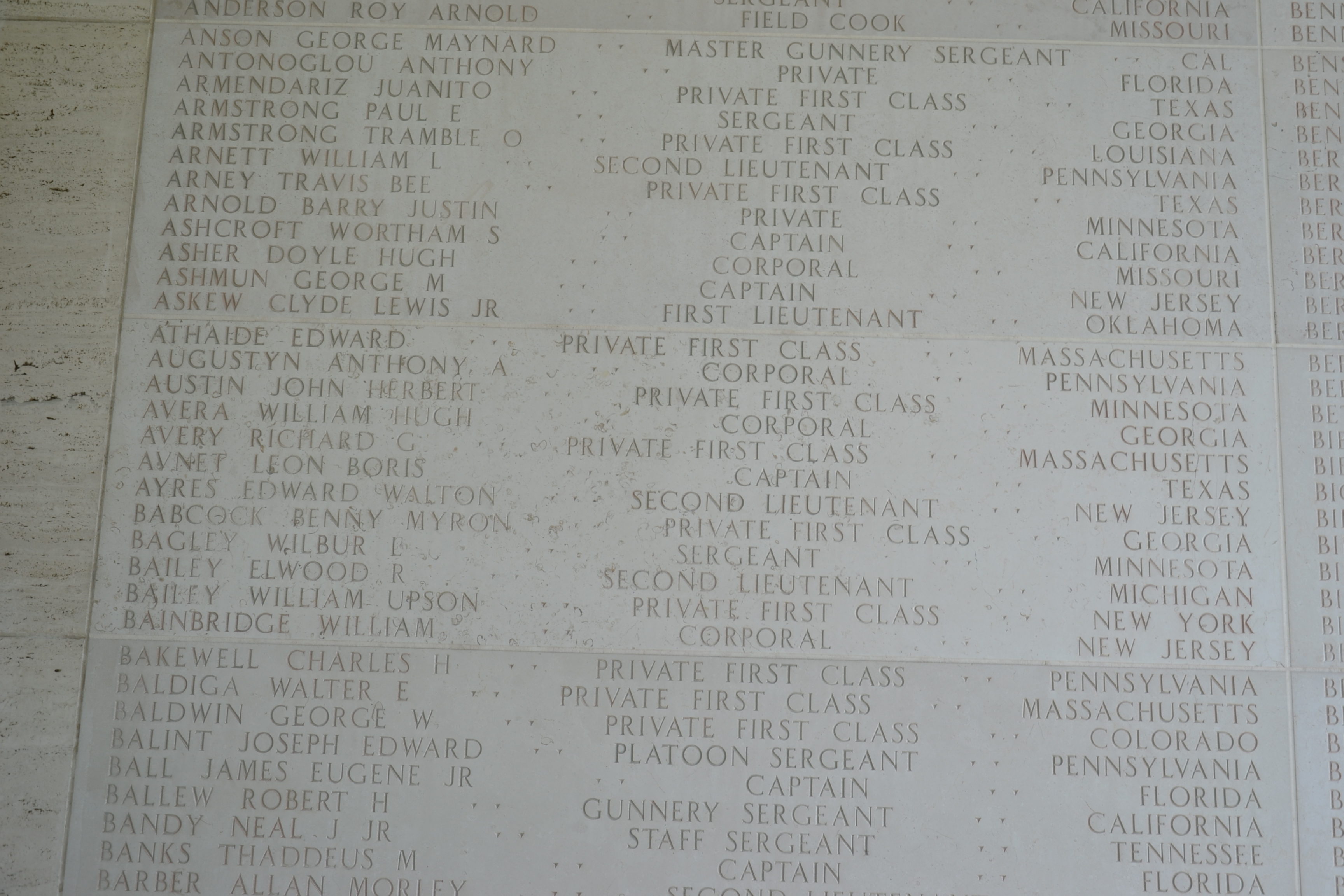The 1930 US Census shows the family as living in Hillside, Union County, New Jersey. The following people are shown as living in the home at the time of the census:
Head William Bainbridge M 45 England
Wife Emma Bainbridge F 39 New Jersey
Son William Bainbridge M 9 New Jersey
Son Robert Bainbridge M 0 New Jersey
Bainbridge joined the Marine Corps Reserve in February, 1939. His reserve unit was based out of the post office building in nearby Elizabeth, New Jersey. He was promoted to Private First Class in January, 1941, and he attended weekly drills with a new friend, PFC Herbert Benson, until the spring of that year, when they were assigned to a Marine artillery unit, Battery D, Second Battalion, Eleventh Marines. He was not there for long as Bainbridge was transferred to the Intelligence Section of the Headquarters and Service Company of the Fifth Marines, and was promoted to Corporal in October, 1941. He rejoined his friend Herbert Benson in that company. Less than two months later, the Empire of Japan attacked Pearl Harbor, Hawaii - "A day that will live in infamy".
In 1942, Bainbridge, Benson and their regiment were assigned to the First Marine Division and deployed to Wellington, New Zealand, for further training. The primary objective of the First Marine Division was to take the fight to the Japanese via an island hopping campaign. Shortly after their arrival at Wellington, the word was passed that they would soon be departing for the war zone. The Intelligence Section was concentrating on a small island in the Solomon Islands named Guadalcanal - it was chosen as their first target.
On August 7, 1942, the Marines landed on Guadalcanal. They expected stiff resistance but the landing was unopposed. The Japanese waited in the jungle for the coming battle with the Marines. The Intelligence Section set about gathering and analyzing information they gleaned from the area. On August 12th, a Marine patrol from the 3rd Battalion, 5th Marine Regiment, captured a Japanese soldier named Sakado, who had been found foraging in the area. The Marines learned from him that the Japanese west of the Matanikau River were a disorganized and demoralized group, short on food and in poor health. They could, Sakado thought, be induced to surrender given the proper conditions.
The commander of the Intelligence Section, Colonel Frank Bryan Goettge, had been annoyed by the rush job that intelligence had been forced into when the regiment was still in New Zealand and the now apparent shortcomings in maps and other data were becoming more evident. Sakado was a godsend to him. Col. Goettge sent First Sergeant Steven Custer to organize a patrol, which Goettge himself would lead, to capture the Japanese force Sakado had told them about. The Marines would take an interpreter, a Navy doctor, a good portion of the intelligence section and some riflemen for support. A boat would take them across a span of shoreline to a secluded beach where a white flag had reportedly been seen. The plan was that they would convince the Japanese there to surrender and work their way back to Headquarters by land the next day, with Col. Goettge presumably at the head of a cluster of happily surrendered Japanese soldiers.
The patrol, consisting of 25 men plus Sakado (who was led by a rope around his neck by Platoon Sergeant Denzil Ray Caltrider) Bainbridge and his old friend, Corporal Herbert Benson, set out from the camp at Kukum at about 1800 hours – a twelve hour delay caused by numerous personnel changes ordered by Col Goettge. The men were traveling light, carrying enough food for one day, a canteen, a poncho, and only light weapons (contrary to the heavy machine-gun 1stSgt Custer had recommended).
Due to tidal issues, the groups delay caused another problem – it was now too late to risk heading for the original planned landing site. Ignoring the warnings of Lieutenant Colonel Bill Whaling and the cries of Sakado, who begged them not to land there, the boat turned for shore and landed about 200 yards west of the Matanikau River. The boat ran up on a sandbar, forcing the Marines to jump over the gun-whales and rock it free, creating quite a racket. They waded in to shore and, taking cover behind a line of banyan trees, held a quick council of war. All the noise they had made and now this pause gave the Japanese soldiers of the 2nd Platoon, 11th CU Security Force under Lt. Soichi Shindo, plenty of time to pick their targets from their fighting positions in the jungle. As Col. Goettge led an advance party into the treeline, two shots rang out. Col. Goettge fell dead with a shot to the head. The seriously wounded 1stSgt Custer dropped beside him. Two Marines who crawled forward to check on the men recovered Goettge's insignia and wristwatch. Command passed to Captain Wilfred Ringer.
As more Marines were killed or wounded, Capt. Ringer called for Bainbridge and ordered him to head back along the beach to the American perimeter to get help. Bainbridge set off at a run and disappeared into the darkness. The survivors formed a defensive perimeter on the beach, and over the course of the night and following morning were gradually picked off by the Japanese defenders. By dawn, the patrol had been wiped out except for three survivors who fled the beach by jumping back into the water and managed to swim back to friendly lines one at a time. They reported seeing Japanese swords "flashing in the sun" as they fell upon the wounded and dead, to include Bainbridge's old friend, Herbert Benson.
The bodies of the Goettge Patrol were never recovered. There were accounts of knowing where they were and that their remains had been thrown into fighting trenches and covered up. There were at least three reports over the following weeks after the fight that the bodies were partially buried in the sand with limbs sticking out of the makeshift graves. One report, made by a Marine years later stated he was on patrol at the scene of the slaughter and personally saw the mutilated bodies of Goettge's patrol to include decapitated torsos and boots with limbs still attached. One decapitated Marine's head was rolling in the surf. The patrol left them, to be recovered later. But no one ever came, and the bodies were never recovered.
A week after the massacre, a patrol from Item Company, Fifth Marines, made a probing attack along the same beach near a place called Kokumbona. On the beach, they found the bullet-riddled body of William Bainbridge. Having been there for a week, his body was in an advanced state of decomposition and made the recovery of his remains at that time, impossible. The patrol leader, Marine Gunner Bill Rust, had Bainbridge buried where he fell with the intent of returning in the near future to recover his body. However, that never occurred either. The location of Bainbridge's remains was lost as the bloody battle on Guadalcanal escalated.
The bodies of Bainbridge, Benson and the rest of the men are lost to this day. Several attempts over the past 75 years have been made to find them but nothing has been found. It is suspected now that building in the area and the changes in the shoreline will result in the patrol's remains never being recovered.
To this day the Goettge Patrol Marines lie together somewhere on Guadalcanal. But William Bainbridge, lies buried alone, and basically forgotten to all but God. (Biography written by Rick Lawrence, MSgt., USMC/USAFR {RET})
Corporal William Bainbridge, Sn #270005, earned the following badges/decorations for his service in the United State Marine Corps during World War II:
- Combat Action Ribbon (Posthumously)
- Purple Heart Medal(Posthumously)
- American Defense Service Medal
- Asiatic-Pacific Theater of Operations Campaign Medal with one bronze battle/campaign star (Posthumously)
- World War II Victory Medal (Posthumously)
- Navy/Marine Corps Presidential Unit Citation Ribbon (Posthumously)
- Marine Corps Rifle marksmanship badge
- Marine Corps Basic Qualification Badge with Bars
The 1930 US Census shows the family as living in Hillside, Union County, New Jersey. The following people are shown as living in the home at the time of the census:
Head William Bainbridge M 45 England
Wife Emma Bainbridge F 39 New Jersey
Son William Bainbridge M 9 New Jersey
Son Robert Bainbridge M 0 New Jersey
Bainbridge joined the Marine Corps Reserve in February, 1939. His reserve unit was based out of the post office building in nearby Elizabeth, New Jersey. He was promoted to Private First Class in January, 1941, and he attended weekly drills with a new friend, PFC Herbert Benson, until the spring of that year, when they were assigned to a Marine artillery unit, Battery D, Second Battalion, Eleventh Marines. He was not there for long as Bainbridge was transferred to the Intelligence Section of the Headquarters and Service Company of the Fifth Marines, and was promoted to Corporal in October, 1941. He rejoined his friend Herbert Benson in that company. Less than two months later, the Empire of Japan attacked Pearl Harbor, Hawaii - "A day that will live in infamy".
In 1942, Bainbridge, Benson and their regiment were assigned to the First Marine Division and deployed to Wellington, New Zealand, for further training. The primary objective of the First Marine Division was to take the fight to the Japanese via an island hopping campaign. Shortly after their arrival at Wellington, the word was passed that they would soon be departing for the war zone. The Intelligence Section was concentrating on a small island in the Solomon Islands named Guadalcanal - it was chosen as their first target.
On August 7, 1942, the Marines landed on Guadalcanal. They expected stiff resistance but the landing was unopposed. The Japanese waited in the jungle for the coming battle with the Marines. The Intelligence Section set about gathering and analyzing information they gleaned from the area. On August 12th, a Marine patrol from the 3rd Battalion, 5th Marine Regiment, captured a Japanese soldier named Sakado, who had been found foraging in the area. The Marines learned from him that the Japanese west of the Matanikau River were a disorganized and demoralized group, short on food and in poor health. They could, Sakado thought, be induced to surrender given the proper conditions.
The commander of the Intelligence Section, Colonel Frank Bryan Goettge, had been annoyed by the rush job that intelligence had been forced into when the regiment was still in New Zealand and the now apparent shortcomings in maps and other data were becoming more evident. Sakado was a godsend to him. Col. Goettge sent First Sergeant Steven Custer to organize a patrol, which Goettge himself would lead, to capture the Japanese force Sakado had told them about. The Marines would take an interpreter, a Navy doctor, a good portion of the intelligence section and some riflemen for support. A boat would take them across a span of shoreline to a secluded beach where a white flag had reportedly been seen. The plan was that they would convince the Japanese there to surrender and work their way back to Headquarters by land the next day, with Col. Goettge presumably at the head of a cluster of happily surrendered Japanese soldiers.
The patrol, consisting of 25 men plus Sakado (who was led by a rope around his neck by Platoon Sergeant Denzil Ray Caltrider) Bainbridge and his old friend, Corporal Herbert Benson, set out from the camp at Kukum at about 1800 hours – a twelve hour delay caused by numerous personnel changes ordered by Col Goettge. The men were traveling light, carrying enough food for one day, a canteen, a poncho, and only light weapons (contrary to the heavy machine-gun 1stSgt Custer had recommended).
Due to tidal issues, the groups delay caused another problem – it was now too late to risk heading for the original planned landing site. Ignoring the warnings of Lieutenant Colonel Bill Whaling and the cries of Sakado, who begged them not to land there, the boat turned for shore and landed about 200 yards west of the Matanikau River. The boat ran up on a sandbar, forcing the Marines to jump over the gun-whales and rock it free, creating quite a racket. They waded in to shore and, taking cover behind a line of banyan trees, held a quick council of war. All the noise they had made and now this pause gave the Japanese soldiers of the 2nd Platoon, 11th CU Security Force under Lt. Soichi Shindo, plenty of time to pick their targets from their fighting positions in the jungle. As Col. Goettge led an advance party into the treeline, two shots rang out. Col. Goettge fell dead with a shot to the head. The seriously wounded 1stSgt Custer dropped beside him. Two Marines who crawled forward to check on the men recovered Goettge's insignia and wristwatch. Command passed to Captain Wilfred Ringer.
As more Marines were killed or wounded, Capt. Ringer called for Bainbridge and ordered him to head back along the beach to the American perimeter to get help. Bainbridge set off at a run and disappeared into the darkness. The survivors formed a defensive perimeter on the beach, and over the course of the night and following morning were gradually picked off by the Japanese defenders. By dawn, the patrol had been wiped out except for three survivors who fled the beach by jumping back into the water and managed to swim back to friendly lines one at a time. They reported seeing Japanese swords "flashing in the sun" as they fell upon the wounded and dead, to include Bainbridge's old friend, Herbert Benson.
The bodies of the Goettge Patrol were never recovered. There were accounts of knowing where they were and that their remains had been thrown into fighting trenches and covered up. There were at least three reports over the following weeks after the fight that the bodies were partially buried in the sand with limbs sticking out of the makeshift graves. One report, made by a Marine years later stated he was on patrol at the scene of the slaughter and personally saw the mutilated bodies of Goettge's patrol to include decapitated torsos and boots with limbs still attached. One decapitated Marine's head was rolling in the surf. The patrol left them, to be recovered later. But no one ever came, and the bodies were never recovered.
A week after the massacre, a patrol from Item Company, Fifth Marines, made a probing attack along the same beach near a place called Kokumbona. On the beach, they found the bullet-riddled body of William Bainbridge. Having been there for a week, his body was in an advanced state of decomposition and made the recovery of his remains at that time, impossible. The patrol leader, Marine Gunner Bill Rust, had Bainbridge buried where he fell with the intent of returning in the near future to recover his body. However, that never occurred either. The location of Bainbridge's remains was lost as the bloody battle on Guadalcanal escalated.
The bodies of Bainbridge, Benson and the rest of the men are lost to this day. Several attempts over the past 75 years have been made to find them but nothing has been found. It is suspected now that building in the area and the changes in the shoreline will result in the patrol's remains never being recovered.
To this day the Goettge Patrol Marines lie together somewhere on Guadalcanal. But William Bainbridge, lies buried alone, and basically forgotten to all but God. (Biography written by Rick Lawrence, MSgt., USMC/USAFR {RET})
Corporal William Bainbridge, Sn #270005, earned the following badges/decorations for his service in the United State Marine Corps during World War II:
- Combat Action Ribbon (Posthumously)
- Purple Heart Medal(Posthumously)
- American Defense Service Medal
- Asiatic-Pacific Theater of Operations Campaign Medal with one bronze battle/campaign star (Posthumously)
- World War II Victory Medal (Posthumously)
- Navy/Marine Corps Presidential Unit Citation Ribbon (Posthumously)
- Marine Corps Rifle marksmanship badge
- Marine Corps Basic Qualification Badge with Bars
Gravesite Details
Entered the service from New Jersey.
Family Members
Sponsored by Ancestry
Advertisement
Advertisement



